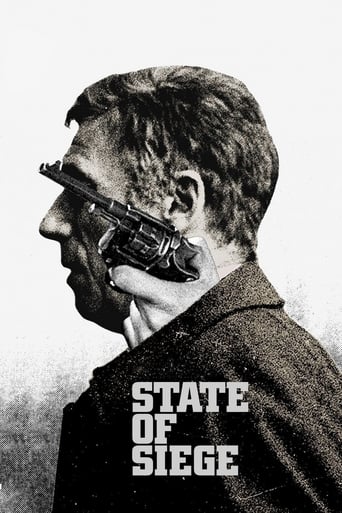ekelks-2
I am a 'Z' and 'The Confession' fan, have been since a teenager. I am about to watch this for the first time. Skimming these reviews, I saw so many people bemoaning the lack of a DVD release, I thought to make note that this film is now (June 2017) streaming on Filmstruck (a service that includes Criterion films). Having read some reviews, I am expecting something truly extraordinary. I am rating it 8 of 10 based on my previous encounters with Costas-Gravas.
grace_g
State of Siege is an exceptional account of how the Uruguayan underground revolution (Tupamaros) developed an extremely challenging resistance against both Uruguayan dictatorship and other parties such as USA and multi nationals who financed such dictatorship. The film describes in great detail the meticulous process used during the resistance, which in turn was adopted in other parts of Latin-America and Asia. Having lived in Uruguay during this time (1970s)i was amazed at the accuracy of the story and the ability by the story teller and the characters to convey a story/narrative that at the time of filming was very much a well hidden secret by both the establishment and its supporters, and the Tupamaros. Great research, and a great opportunity for those who are interested in Latin America political system as well as getting an effective snapshot of a time in history.
Joseph P. Ulibas
State of Siege (1973) was another classic film from Greek film maker Costa-Gavras. This time the director turns his attention to Latin America. The C.I.A. is running things in South America, one of their fronts is a fake corporation. A group of left wing rebels decide to kidnap the head of A.I.D. Phillip Santore (Yves Montand). During his capture, the rebel leader talks to the captured government official and tries to learn why the C.I.A. is in Uruguay and why they're training the local police in brutal torture tactics. He never learns why they want to suppress left-wing politics because Mr. Santore has become expendable. The American and Uruguay officials don't want to deal with the "terrorists" and don't mind losing one of their own because he can always be replaced. Too bad the rebels don't learn that fact. The military crushes the rebels and to his word, the U.S. Government replaces Santore with another A.I.D. official.Another great film from Costa-Gavras. He utilizes the film techniques that he used in Z and exploits them even further. This film caused even more controversy because the film was based on a true story. Bewarned, the torture techniques that the U.S. advisers teach the Uruguay officials are real graphic and gruesome. It's a shame that this movie has been neglected for so many years. But film makers like Oliver Stone were highly influenced by this movie. Maybe some day State of Siege will be restored and released on video. It's a real hard film to get a hold of.Highest recommendation possible.
Juan Pablo Moreno
In May, 2002 they are fulfilled 30 years of the beginning of the filming of this movie in several leases of Chile (Santiago, Viña del Mar, Valparaíso and Playa Ancha). It was in the second year of the socialistic government of the President Allende and the tension that is perceived in the movie was the one that already was living through the country a year before the military coup of 1973. The Chileans only we could see this movie 2001 and in an alone cinema-art in Santiago that exhibited it for two weeks. In May, 2002 the channel of French cable TV5 exhibited "State of Siege" four times, which has allowed a deeper critical review and to recognize a series of places of the Chile of 30 years ago, which already do not exist or which are now deeply modified. Besides the climate of the epoch there is perceived the precarious or simple car equipment that Chileans were having in that epoch in which the cars of luxury were the Dodge Dart Chrysler (assembled in the northern port of Arica) and the Peugeot 404 (assembled in Los Andes, 100 kms. from Santiago). The car of the well-off middle class was the Fiat 125 and en their juvenile sectors the ideal was a Mini Austin 850. In the installed middle class there were meeting old Renault 4S (the "renolas" o "renoletas"), VW beetles, Simca 1000 and principally the popular one Citroen 2CV, known like "citroneta" o "citrola". The movie allows to see brief the juvenile or young faces of approximately 30 actors, the majority today mature and well known and to wonder for the identities of others that probably retired, they did not come back from exile or were murdered or disappear during the dictatorship. In short an intelligent and nervous "thriller", in "Z" style, which showing the hard political reality of Uruguay between 1970 and 1972. The film allows a nostalgic look and indicative on the Chile that was on the way to disappear due the Coup d'Etat of 11 of september, 1973.




